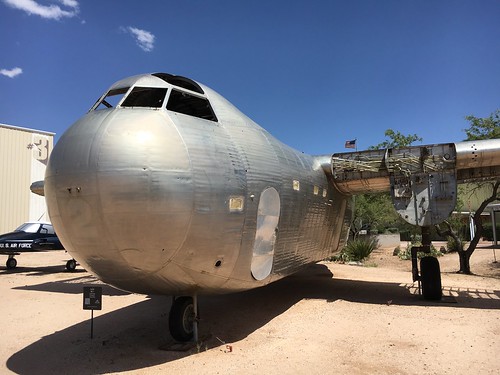A week or two ago, this photo, captioned as shown, showed up on a Facebook aviation page.

If you follow aviation accounts on social media, you’ve probably noticed how quickly aviation buffs pounce on photos of unidentified aircraft. In this case, though, no one, not even the original poster, offered an ID on the Cubana Airlines aircraft. I knew what it was at first glance, but refrained from commenting. Instead, I saved the photo for an Air-Minded blog post.
And here we are: it’s a Budd Conestoga.

Few have ever seen one. Even when they were actively flying in in the 1940s, 50s, and 60s, there were never more than a handful; 50 years after the last one touched down only a single example survives, hidden in the back lot of an air museum in Tucson, Arizona.
Which is why I recognized it right away. The last Conestoga in the world is at Pima Air and Space Museum, where I worked as a volunteer docent. It was one of my favorites, and every time I took visitors on tram tours I’d go out of my way to point it out and say a few things about it. Here it is today:


You can get the deets on the Budd Conestoga on Wikipedia and other websites. Links to those resources are at the end of this post; for now, here’s the basic scoop on the museum’s unique relic.
During WWII America built aircraft by the tens of thousands, not just for its own military but for allied nations as well. Shortages of strategic materials were always a concern, and aluminum was high on the worry list. The War Department directed efforts to build aircraft with alternate materials; the Conestoga was one such attempt.
Conestogas were designed and constructed by the Budd Company, a Philadelphia-based builder of railroad cars and bodies for automobiles, buses, and trucks. The Conestoga was made with shotwelded stainless steel, as with other Budd products.
The Army and Navy initially ordered several hundred Conestogas, but by the time the prototype flew in late 1943 aluminum production had caught up with demand and other, more conventional, cargo & transport aircraft were being built in quantity. In the end only 20 Conestogas were built, 3 test aircraft and 17 production units for the Navy, which designated it the RB-1.
Budd’s design was innovative for its day: the cargo compartment sat level with the ground; the cockpit, wings, and tail were placed above the cargo area; it had a powered loading door in the back. This pioneering design lives on in more modern military transports, from the Lockheed C-130 Hercules and C-141 Starlifter to Boeing’s C-17 Globemaster III.


The loading door could be lowered to the ground to serve as a vehicle ramp; it could also be lowered to a level position so that freight could be moved directly from truck beds into the cargo bay. Inside, an electrically powered overhead cargo hoist and winch helped position heavy pallets and vehicles.
On the downside, the Conestoga was powered by the same twin-row Pratt & Whitney radial engines used in the Douglas C-47, which it outweighed by 3,000 pounds, so its performance was doggish (the old joke was that for a plane built a railroad car company, it not surprisingly flew like one).
The Navy accepted its 17 RB-1s in 1944 and retired them in early 1945. During their brief wartime service they saw no combat, instead flying as utility aircraft at home-based naval air stations. After the Navy retired them, they were transferred to the War Assets Administration, which sold them as surplus. The most notable buyer was National Skyway Freight Corporation in Long Beach, California, which bought 12 surplus RB-1s.

Skyway, also known as the Flying Tiger Line, sold four of its newly-acquired Conestogas to an oil company in Central America, then operated the rest from its home base in Long Beach, California. Skyway flew Conestogas into the 1950s, by which time it had officially changed its name to Flying Tiger Line. The company soon picked up government contracts and began upgrading its fleet with larger and more modern aircraft.
The remaining military surplus Conestogas, along with the ones retired by Flying Tiger Line, found their way south of the border, where they hauled freight for a number of operators, some continuing to fly well into the 1960s.
According to this history of the Conestoga fleet, of the 17 aircraft originally delivered to the Navy and subsequently sold as military surplus to civilian air freight companies in various locations, 6 were destroyed in crashes (most of which were fatal) and another 2 were written off after landing accidents (indeed, one became a Texas hamburger stand after a landing crash). Not a great record.

The sole surviving Conestoga flew for Aerovias Azteca in Mexico. One story goes that at some point it was used to smuggle drugs into the US and was seized by the DEA. Another story says it was abandoned near the US/Mexico border during an aborted delivery flight to Cuba. What is known for sure is that it sat for many years on the grounds of the airport in Douglas, Arizona, and was eventually sold at auction in non-flying condition. The purchaser subsequently donated it to Pima Air and Space Museum, where it sits today.
I’ll finish with one last photo, a really cool shot taken inside a US Navy dirigible hangar. You can see a single RB-1 Conestoga at the lower left, and, if you’re a fellow aviation buff, have fun identifying the other aircraft in the hangar. I confess to feeling some nomenclatorial urges myself!

Links:
Very informative. Typo maybe- ‘shotwelded’ or ‘spotwelded’?
Must have been a fairly early use of high stinger tail, ramp, roll on/off easy loading a la C-123 or C-130.
‘Tod’ recently posted…ERCO Ercoupe Light Sport Aircraft: Antique Flying Art